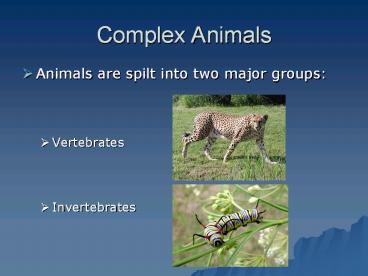Complex Animals - PowerPoint PPT Presentation
1 / 20
Title: Complex Animals
1
Complex Animals
- Animals are spilt into two major groups
- Vertebrates
- Invertebrates
2
Arthropods - Jointed-leg
- Have lots of legs and segmented bodies.
- There are five group of arthropods
- Crustaceans - First Class
- Arachnids - Second Class
- Centipedes - Third Class
- Millipedes - Fourth Class
- Insects - Fifth Class
3
Arthropods - Jointed-leg animals
- Bilateral symmetry
- Appendages - a structure that grows out of the
body. Legs, claws antennae(smell,touch) - Exoskeleton - outside skeleton
- Hard waterproof substance
- Protection and protects from drying out
- Provides a place for muscle to attach
- Molting - shedding of exoskeleton.
vulnerable state - Compound eyes - eyes with many lenses
4
Arthropods - Crustacean
- Crab, lobster, crayfish, pillbug shrimp
- Have five-seven pairs of legs with claws
- Bodies covered in shell
- Head-thorax fused
5
Arthropods - Arachnid
- Examples from photos
- Have four pairs of legs.
- Have bodies divided into two sections -
Head/thorax abdomen
6
Arthropods Centipedes Millipedes
- Have long thin bodies and pairs of legs on each
of their many body sections - Centi - eats insects
- 2 legs/segment
- Milli - eats decaying plants.
- 4 legs/segment
7
Arthropods - Insects
- Examples from photos
- Have three pairs of legs
- Bodies divided into three sections
- Often have wings
- Eat insects, pollinate
8
Echinoderms - Spiny-skin
- Examples from photos
- Bodies divided into five parts - Symmetry?
- Have spiny outer covering
- Tube feet are used for
- movement and feeding
9
Vertebrates - most complex of all animals.
- These are animals with a
- backbone - Chordate phylum.
- Chordate -
- an animal that,
- at some point in its
- life has a tough,
- flexible rod
- along its back.
10
There are Seven Classes of vertebrates
- Fish - Jawless, Cartilage, Bony
- Amphibians
- Reptiles
- Birds
- Mammals
11
Fish
- Cold-blooded - cannot maintain its body
temperature - Female lays eggs in water - Males deposit sperm.
- Lives in water
- Most have gills(breathing) and scales for
protection
12
Jawless Fish
- Examples
- Sea lamprey Hagfish
- Snake-like body
- Lack jaws
- Parasitic - hook on to a prey suck blood
- Bodies are covered with slime
13
Cartilage Fish
- Examples from photos
- Skeleton is made of cartilage
- Many rows of teeth and paired fins
- Shark scales are tooth-like
- Rays have flat bodies and live on the ocean
bottom - Stingers in their tails - poison
14
Bony Fish
- Examples from photos
- Skeleton is made of bone
- Paired fins and bony scales
- Bony fish have swim bladders that aid in
horizontal movement - Ensures reproduction by laying thousands of eggs.
15
Amphibians
- Examples from photos
- Lives on land and water
- 2 reasons to be tied to water lay jelly coated
eggs in water has to keep skin moist - Cold blooded - cannot maintain body temp
hibernation - Metamorphosis
16
Reptiles
- Examples from photos
- Have dry scaly skin
- First chordates to live totally on land
- Lay leathery shelled eggs
- Cold blooded - cant maintains body temp
- Internal fertilization
17
Birds
- Examples from photos
- Have feathers, hollow
- bones air sacs
- Lay hard shelled eggs
- Warm blooded - maintains
- internal body temp
- Eat insects food source
- Diff. beaks for diff. food
18
Mammals
- Have hair and produce milk - mammary glands
- Give birth to live offspring (no eggs)
- Warm blooded
19
Mammals - two other groups
- Kangaroos opossums - pouch mammals
- Duck-billed platypus - egg-laying mammal
- (monotremes)
20
Summary of Vertebrates































